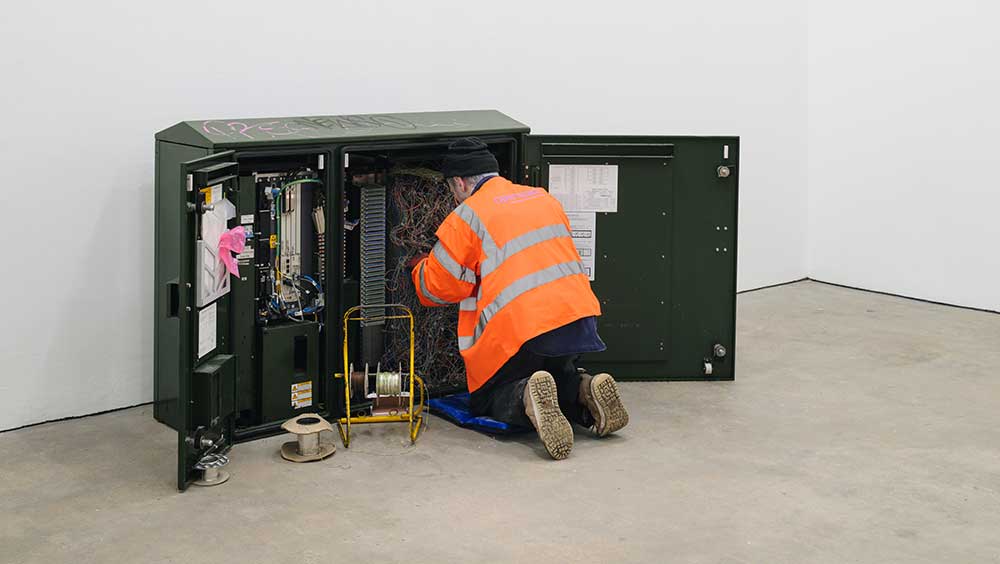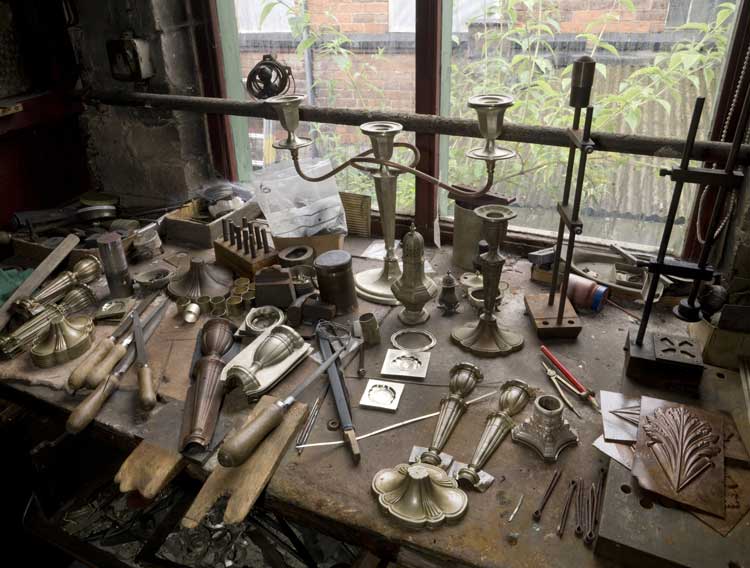
Dion Kitson, Rue Britannia, installation view, Ikon Gallery, 2024. Image courtesy Ikon. Photo: Tom Bird.
Ikon Gallery and JW Evans Silver Factory, Birmingham
10 May – 8 September 2024
by DAVID TRIGG
The broadband is on the blink at the Ikon Gallery – or so it appears. A graffiti-covered telecoms cabinet, teeming with spaghetti-like wires and attended to by a waxwork Openreach engineer, stands at the entrance of Dion Kitson’s exhibition Rue Britannia. It sets the scene for a selection of incisive, witty and, at times, bleak sculptures in which the Black Country artist muses on aspects of class, identity and the ruination of everyday life in modern Britain. Titled Ill Communication (2024), the show’s opener perhaps alludes to a breakdown in public discourse and civil debate. Conversely, it could refer to the role of overlooked workers in keeping us all connected. Further still, the work’s title, borrowed from the Beastie Boy’s acclaimed 1994 album, may be a tongue-in-cheek boast regarding the cogency, or otherwise, of Kitson’s art. Such ambiguity abounds throughout the exhibition.
Many of Kitson’s works draw on his experience of growing up in the English market town of Dudley, one of the birthplaces of the Industrial Revolution and now rife with concentrations of deprivation. The architectural installation Council House of Kitson (2024) recreates the pebble-dash exterior and interior (yes, really) of his father’s home. Inside the bizarre, cave-like living room is the video Birdman (2012-2024), which documents the activities of Kitson senior over a period of 12 years. A heavy smoker and keen consumer of raw sausages, he is also an animal lover, as evidenced by the number of animals, particularly orphaned birds, for which he provides refuge. It is a touching portrait of an eccentric yet highly caring and sensitive man.
-Photo-Steve-Russell-Studios.jpg)
Dion Kitson, Ode to Brierley Hill's Rubbish Mountain, 2023. Scale model of waste management site. Image courtesy the artist. Photo: Steve Russell Studios.
Beyond the pebbledash is Ode to Rubbish Mountain (2023), a light-hearted response to the 30ft mountain of waste that blighted Brierley Hill in Dudley in the early 2010s. The epic 2,000-ton pile, which eventually grew to 42ft and was finally removed in 2016 after a five-year local battle, is painstakingly recreated in the style of a model rail enthusiast, wittily subverting hobbyist materials to depict a regional scandal. Nearby, a newspaper cutting and a BBC news report document the hysteria created by the refuse and its removal. As one of the show’s most hopeful works, it suggests that problems faced by local communities are not necessarily insurmountable.
-photo-by-Tom-Bird-(6).jpg)
Dion Kitson, Rue Britannia, installation view, Ikon Gallery, 2024. Image courtesy Ikon. Photo: Tom Bird.
Kitson’s humour and playful approach ostensibly aims to disrupt the rarefied atmosphere of the gallery. This is especially true of the fun yet prosaically titled Pool Table and Cues (2024), in which a real pool table – staple of the great British pub – invites visitors to a game. You can choose to play with standard cues or with those that Kitson has quirkily modified to resemble domestic mops and brooms, which sets up an intriguing dichotomy between labour and leisure.
-photo-by-Tom-Bird-(3).jpg)
Dion Kitson, Still Life, 2024. Installation view, Rue Britannia, Ikon Gallery, 2024. Image courtesy Ikon. Photo: Tom Bird.
It is not all fun and games though. Within sight of the pool table is a 3D printed mannequin dressed for a funeral. The black-suited figure faces the wall like a naughty schoolboy but on closer inspection is revealed as a 12-year-old Prince Harry. Titled Still Life (2024), the uncannily realistic sculpture depicts the young prince during the funeral service for his mother, Diana, Princess of Wales. With his head lowered, the solitary figure symbolises the collective grief of a nation. Considering that Kitson, who was born in 1995, was just a toddler when Diana died in August 1997, the subject is curious yet demonstrates the lasting impact the tragedy has had on British culture.
-photo-by-Tom-Bird-(5).jpg)
Dion Kitson, Still Life, 2024. Installation view, Rue Britannia, Ikon Gallery, 2024. Image courtesy Ikon. Photo: Tom Bird.
Other works in the show are tinged with pathos. Waiting (2024) consists of a child’s trampoline mat split down the middle and displayed on a wall. Found in a neighbour’s garden, the torn apparatus speaks to the disappointment of a broken toy while making an association with the slashed canvases of Lucio Fontana (1899-1968). For Fontana, art was a means of transcending earthly limitations to connect with an infinite, immaterial and spiritual dimension. In contrast, Kitson’s one liner remains firmly terrestrial, rooted in childhood disenchantment.
-photo-by-Tom-Bird.jpg)
Dion Kitson, Rue Britannia, installation view, Ikon Gallery, 2024. Image courtesy Ikon. Photo: Tom Bird.
“Waiting” would have made a good title for the ongoing series of large dry point etchings that Kitson makes with the vandalised windows of bus stops. While many windows are glass, others use Perspex, a material especially susceptible to scratches. Several years ago, Kitson discovered a kicked-out window that was covered in scratches – the doodling of bored teenagers. The deep marks reminded him of an etching plate and, after finding a printing press large enough, he set about taking prints. Four such etchings are included here, featuring a dynamic mix of abstract and figurative marks, tags and cryptic messages. True outsider art, these works of social history speak to the boredom, disillusionment and frustration that many young people experience growing up in the UK.
-photo-by-Tom-Bird-(8).jpg)
Dion Kitson, Rue Britannia, installation view, Ikon Gallery, 2024. Image courtesy Ikon. Photo: Tom Bird.
Towards the end of the exhibition, suspended above our heads and easy to miss, is a pair of ruby red slippers, famously worn by the character Dorothy in the 1939 fantasy film The Wizard of Oz. Dangling from telegraph wire, the glittering footwear evokes urban legends regarding the phenomenon of laced shoes flung on to overhead cables, which are rumoured to indicate spots for drug deals or gang turf. Titled No Place Like Home (2024), the work transcends these street level speculations, for in the film, Dorothy’s ruby slippers possess the power to magically transport her back home to Kansas, a place of childhood innocence. What “home” does Kitson yearn for? A Britain of the past? Or maybe a future version of the here and now? It is a question the artist literally leaves hanging.
A short walk from the Ikon Gallery, in Birmingham’s Jewellery Quarter, is JW Evans, a preserved silver factory run as a museum by English Heritage. Here, Kitson is presenting a new commission, Silver Lining, which comprises a collection of characteristically droll objects and sculptural interventions dispersed throughout the factory that respond to its history. A Newton’s cradle fashioned from laughing gas canisters sits in the former director’s office; a trophy cabinet is filled with deflated footballs; a silver heroin spoon and a hammer supposedly bent via telekinesis mingle with vintage silversmithing tools, while cigarette butts cast in gold are held in a vice. The Tin Man from Oz, created from a cast of Kitson’s own face, also makes an appearance, linking with Dorothy’s slippers back at the Ikon Gallery.

Finished candlesticks sit alongside moulds and tools. JW Evans produced a huge range of tableware, jewellery and other items, especially in the years leading up to the first world war. Image courtesy English Heritage.
Certainly, there is much to rue about life in modern Britain, but Kitson’s work is not a lament. Nor is it overtly political, or in any way didactic. Rather, it teases out the beauty in the mundane, finds humour amid the bleakness, and sees poetry in the dilapidated. Above all, though, it is strikingly human, grounded in the shared experience of the present moment.